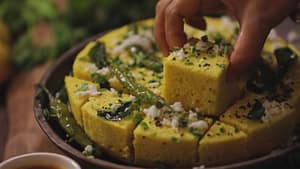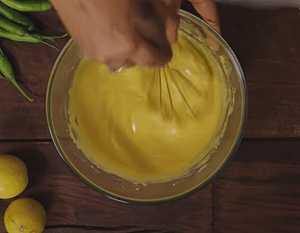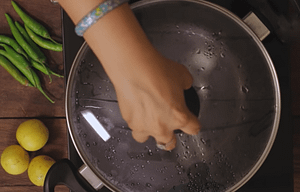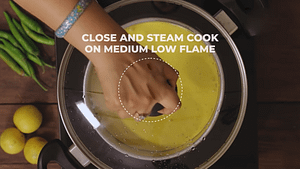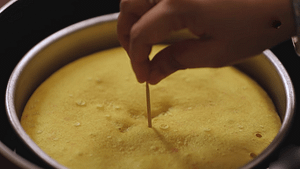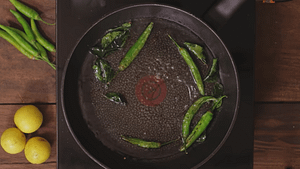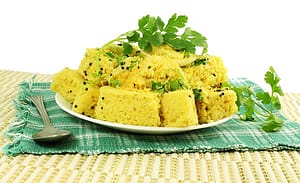How To Make Soft And Spongy Gujarati Dhokla
Dhokla, a savory sponge dish, originates from the Indian state of Gujarat and is widely enjoyed across the country. This delectable dish is crafted from a fermented batter, steamed to achieve a cake-like consistency. The batter is traditionally a blend of rice and Bengal gram pulses, though variations exist with substitutions like chickpeas, pigeon peas, or urad beans.
Place of origin : India
Primary components: Blend of divided lentils and rice.
Alternative names: Dhokla
Course: Breakfast, side dish, main course
Serving temperature: Hot & cold
Ingredients
For Dhokla Batter:
1. Gram flour -1 1/2 cup
2. Salt – 1/2 tsp
3. Sugar- 1/2 tsp
4. Turmeric powder- 1/2 tsp
5.Eno fruit salt – 1 tsp Water
For Dhokla syrup:
- Oil – 1 tsp
2. Mustard seeds- 1/2 tsp
3. Green chilies – 5 nos. (slit)
4. Curry Leaves
5. Water – 1/2 cup
6. Salt – 1/2 tsp
7. Sugar – 2 tsp
8. Coriander leaves (chopped)
9. Juice of 1/2 lemon
10. 2 tablespoons grated Fresh Coconut
How To Make Soft And Spongy Gujarati Dhokla
I will teach you the simple method of how you can get the taste of Gujarati dhokla at home .You can make this Gujarati dhokla very easily. Dhokla is a popular dish in India that can be eaten for breakfast and lunch This dhokla dish is not only limited to Indians, the taste of the dish has spread to every corner abroad. So you can easily make this food at home to taste it yourself.
1. Prepare Dry Ingredients:
In a mixing bowl, combine gram flour, sugar, salt, and turmeric powder. Ensure a thorough mix of these dryingredients.
2. Add Water and Rest the Batter:
Gradually add water to the dry mixture, stirring continuously to achieve a smooth, flowing consistency. Give the batter a 10-minute break before proceeding.
3. Grease Cake Tin:
Grease a cake tin with oil, ensuring it is evenly coated.
4. Add Eno Fruit Salt:
Just before pouring the batter into the cake tin, gently mix in eno fruit salt.
5. Pour Batter into Tin:
Pour the batter into the cake tin promptly after preparation.
6. Prepare Steaming Setup:
Heat a pressure cooker or pot with water. Place a stand inside and bring the water to a boil.
7. Steam Cook Dhokla:
Position the cake tin on the stand in the pot. Close and steam cook the dhokla for approximately 20 minutes on medium low flame.
8. Check Doneness:
Use a toothpick to check if the dhokla is fully cooked. When inserted, it ought to emerge without any residue.
9.Cool Dhokla:
Remove the tin and let the dhokla cool down to room temperature.
9. Prepare Tempering:
Heat a pan with oil, add mustard seeds, and let them splutter. Add green chilies and curry leaves. After a few minutes, pour water, add salt, and sugar.Bring it to a boiling point and subsequently switch off the stove. Stir in lemon juice and coriander leaves.
10. Soak Dhokla in Tempering:
Check the dhokla and ensure it has cooled to room temperature. Cut it into squares and pour the prepared tempering over the dhokla, allowing it to soak.
11. Garnish and Serve:
Finally, garnish the dhokla with grated coconut and additional coriander leaves. Your delicious dhokla is now ready to be served.
FAQS:
A. What is the dhokla made of?
Ans: Dhokla is crafted from a fermented batter comprising rice and lentils such as chana dal or urad dal. In contrast, the khaman recipe calls for an instant preparation using gram flour, and its batter does not undergo fermentation, unlike that of dhokla.
B. Is dhokla sweet or hot?
Ans : Gujarati Dhokla comes in various forms, and Khaman Dhokla is one such variant. Unlike the other types of Dhokla, which are white and made from a blend of rice flour and chickpea flour, Khaman Dhokla stands out for its dual sweet and zesty flavor profile. In contrast, the remaining Dhokla variations typically offer a tangy taste without the combination of sweetness.
C. Is dhokla junk food?
Ans : Certainly, Gujarati Dhokla qualifies as a nutritious breakfast choice! Originating from Gujarat, this traditional Indian dish is crafted from fermented rice and chickpea flour. Its preparation involves steaming instead of frying, ensuring the preservation of its nutritional value.
